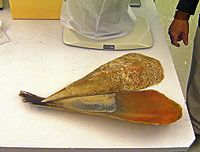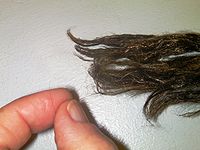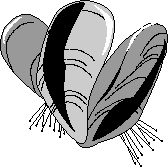
Byssus
Encyclopedia

Sea silk
Sea silk is an extremely fine, rare and valuable fabric produced from the long silky filaments or byssus secreted by a gland in the foot of several bivalve molluscs by which they attach themselves to the sea bed....
and its fibre source.
Word
The EnglishEnglish language
English is a West Germanic language that arose in the Anglo-Saxon kingdoms of England and spread into what was to become south-east Scotland under the influence of the Anglian medieval kingdom of Northumbria...
term byssus or bissus (plural byssuses or byssi) originated in John Trevisa
John Trevisa
John Trevisa , was a Cornish writer and translator.Trevisa was born at Trevessa in the parish of St Enoder in mid-Cornwall, and was a native Cornish speaker...
's translation (1398) of Bartholomeus Anglicus's Latin On the Properties of Things (1240), referring to finest white flax from Egypt. From originally meaning "fine linen
Linen
Linen is a textile made from the fibers of the flax plant, Linum usitatissimum. Linen is labor-intensive to manufacture, but when it is made into garments, it is valued for its exceptional coolness and freshness in hot weather....
", the semantics
Semantics
Semantics is the study of meaning. It focuses on the relation between signifiers, such as words, phrases, signs and symbols, and what they stand for, their denotata....
of byssus gradually expanded.
The etymology
Etymology
Etymology is the study of the history of words, their origins, and how their form and meaning have changed over time.For languages with a long written history, etymologists make use of texts in these languages and texts about the languages to gather knowledge about how words were used during...
of byssus, according to the OED2
Oxford English Dictionary
The Oxford English Dictionary , published by the Oxford University Press, is the self-styled premier dictionary of the English language. Two fully bound print editions of the OED have been published under its current name, in 1928 and 1989. The first edition was published in twelve volumes , and...
, began with Biblical Hebrew būts or butz בוץ meaning "a fibre or fabric distinguished for its whiteness", cognate
Cognate
In linguistics, cognates are words that have a common etymological origin. This learned term derives from the Latin cognatus . Cognates within the same language are called doublets. Strictly speaking, loanwords from another language are usually not meant by the term, e.g...
with Aramaic
Aramaic language
Aramaic is a group of languages belonging to the Afroasiatic language phylum. The name of the language is based on the name of Aram, an ancient region in central Syria. Within this family, Aramaic belongs to the Semitic family, and more specifically, is a part of the Northwest Semitic subfamily,...
ܒܘܫ bus and Arabic
Arabic language
Arabic is a name applied to the descendants of the Classical Arabic language of the 6th century AD, used most prominently in the Quran, the Islamic Holy Book...
بعد bāḍ "to be white, to surpass in whiteness". This Hebrew term was translated as Latin byssus and Greek
Greek language
Greek is an independent branch of the Indo-European family of languages. Native to the southern Balkans, it has the longest documented history of any Indo-European language, spanning 34 centuries of written records. Its writing system has been the Greek alphabet for the majority of its history;...
βύσσος "a fine yellowish flax, and the linen made from it, but in later writers taken for cotton, also silk, which was supposed to be a kind of cotton".
The OED2 lists five meanings
Meaning (linguistics)
In linguistics, meaning is what is expressed by the writer or speaker, and what is conveyed to the reader or listener, provided that they talk about the same thing . In other words if the object and the name of the object and the concepts in their head are the same...
of byssus in historical order (with dates of earliest references). Note that "†" denotes obsolete meanings.
- 1. "An exceedingly fine and valuable textile fibre and fabric known to the ancients; apparently the word was used, or misused, of various substances, linen, cotton, and silk, but it denoted properly (as shown by recent microscopic examination of mummy-cloths, which according to Herodotus were made of βύσσος) a kind of flax, and hence is appropriately translated in the English Bible 'fine linen'." (1398)
- †2. "A name formerly given to filamentous fungoid growths of different kinds, which are now more accurately classified. Obs." (1753)
- 3. "Zool. The tuft of fine silky filaments by which molluscs of the genus Pinna and various mussels attach themselves to the surface of rocks; it is secreted by the byssus-gland in the foot. 'These filaments have been spun, and made into small articles of apparel.. Their colour ranges from golden yellow to rich brown; they also are very durable.. The fabric is so fine that a pair of stockings may be put in an ordinary-sized snuff-box'" [William Beck's 1886 The Draper's Dictionary]. (1836)
- 4. "Bot. 'The thread-like stipe of some fungi'." (1866)
- †5. "A name formerly given to asbestos." (1864)
Excluding the botanical meaning (4) "rhizomorphs or grouped hyphae of certain fungi that roughly resemble a bivalve shell" and the obsolete (2) "fungoid filament" and (5) "asbestos
Asbestos
Asbestos is a set of six naturally occurring silicate minerals used commercially for their desirable physical properties. They all have in common their eponymous, asbestiform habit: long, thin fibrous crystals...
", byssus refers to (1) "a rare fabric produced in ancient Mediterranean cultures" which is manufactured from (3) "a thread-like mollusc filament".
Fabric


Sea silk
Sea silk is an extremely fine, rare and valuable fabric produced from the long silky filaments or byssus secreted by a gland in the foot of several bivalve molluscs by which they attach themselves to the sea bed....
is an exceptionally fine and valuable fabric from ancient times, usually made from the byssus of molluscs.
The Greek text of the (196 BCE) Rosetta Stone
Rosetta Stone
The Rosetta Stone is an ancient Egyptian granodiorite stele inscribed with a decree issued at Memphis in 196 BC on behalf of King Ptolemy V. The decree appears in three scripts: the upper text is Ancient Egyptian hieroglyphs, the middle portion Demotic script, and the lowest Ancient Greek...
records that Ptolemy V reduced taxes on priests, including one paid in byssus cloth, usually translated as "fine linen cloth". In ancient Egyptian burial customs, byssus cloth was used to wrap mummies.
Filament



Substrate (marine biology)
Stream substrate is the material that rests at the bottom of a stream. There are several classification guides. One is:*Mud – silt and clay.*Sand – Particles between 0.06 and 2 mm in diameter.*Granule – Between 2 and 4 mm in diameter....
, or sea beds. In edible mussel
Mussel
The common name mussel is used for members of several families of clams or bivalvia mollusca, from saltwater and freshwater habitats. These groups have in common a shell whose outline is elongated and asymmetrical compared with other edible clams, which are often more or less rounded or oval.The...
s the inedible byssus is commonly known as the "beard
Beard
A beard is the collection of hair that grows on the chin, cheeks and neck of human beings. Usually, only pubescent or adult males are able to grow beards. However, women with hirsutism may develop a beard...
", and is removed before cooking.
Byssus specifically refers to the long, fine, silky threads secreted by the large Mediterranean pen shell, Pinna nobilis
Pinna nobilis
Pinna nobilis, common name the "noble pen shell" is a species of pen shell, a large marine bivalve mollusc in the family Pinnidae, the 'pen shells'....
. The byssus threads from this Pinna
Pinna (genus)
Pinna is a genus of pen shells. It is a cosmopolitan genus of bivalve molluscs characterized by elongated, wedge-shaped shells which most commonly stand point-first in the sea bottom in which they live, anchored by a net of byssus threads....
species can be up to 6 cm in length and have historically been made into cloth.
Many species of mussels secrete byssus threads to anchor themselves on hard surfaces, with Families including the Arcidae, Mytilidae
Mytilidae
Mytilidae is a family of small to large saltwater mussels, marine bivalve mollusks in the order Mytiloida. It is the only family in the order...
, Anomiidae
Anomiidae
Anomiidae is a family of bivalve molluscs related to scallops and oysters, and known as anomiids. It contains seven genera.The family is known by several common names, including jingle shells, saddle oysters and mermaid's toenails....
, Pinnidae
Pinnidae
Pinnidae is a family of large saltwater clams sometimes known as pen shells. They are marine bivalve molluscs in the order Pterioida.The shells are fragile and have a long and triangular shape, and in life they are anchored in sediment using a byssus...
, Pectinidae
Pectinidae
The Pectinidae are a family of bivalve mollusks including the scallop and closely related to the clam and oyster. They are hermaphrodite, and the male gonads mature first. Pectinidae can live attached by means of a filament they secrete, or are simply recumbent. Their valves can propel them...
, Dreissenidae
Dreissenidae
The Dreissenidae are a family of small freshwater mussels, aquatic bivalve mollusks. They attach themselves to stones or to any other hard surface using a byssus.-Genera:Genera within the family Dreissenidae include:* Congeria...
, and Unionidae
Unionidae
Unionidae is a family of freshwater mussels, the largest in the order Unionoida, the bivalve mollusks sometimes known as river mussels, naiads, or simply as unionids.The range of distribution for this family is world-wide...
.
When a mussel's foot encounters a crevice, it creates a vacuum chamber by forcing out the air and arching up, similar to a plumber's plunger unclogging a drain. The byssus, which is made of keratin
Keratin
Keratin refers to a family of fibrous structural proteins. Keratin is the key of structural material making up the outer layer of human skin. It is also the key structural component of hair and nails...
, quinone
Quinone
A quinone is a class of organic compounds that are formally "derived from aromatic compounds [such as benzene or naphthalene] by conversion of an even number of –CH= groups into –C– groups with any necessary rearrangement of double bonds," resulting in "a fully conjugated cyclic dione structure."...
-tanned proteins (polyphenolic protein
Polyphenolic protein
Polyphenolic proteins are proteins produced by some algae and marine invertebrates like the blue mussel, Mytilus edulis or the polychaete Phragmatopoma californica that are used as bioadhesives. These proteins contain a high level of L-DOPA and cystine....
s), and other proteins, is spewed into this chamber in liquid form, and bubbles into a sticky foam. By curling its foot into a tube and pumping the foam, the mussel produces sticky threads about the size of a human hair
Hair
Hair is a filamentous biomaterial, that grows from follicles found in the dermis. Found exclusively in mammals, hair is one of the defining characteristics of the mammalian class....
. The mussel then varnishes the threads with another protein, resulting in an adhesive.
Byssus is a remarkable adhesive, one that is neither degraded nor deformed by water, as are synthetic adhesives. This property has spurred genetic engineers
Genetic engineering
Genetic engineering, also called genetic modification, is the direct human manipulation of an organism's genome using modern DNA technology. It involves the introduction of foreign DNA or synthetic genes into the organism of interest...
to insert mussel DNA
DNA
Deoxyribonucleic acid is a nucleic acid that contains the genetic instructions used in the development and functioning of all known living organisms . The DNA segments that carry this genetic information are called genes, but other DNA sequences have structural purposes, or are involved in...
into yeast
Yeast
Yeasts are eukaryotic micro-organisms classified in the kingdom Fungi, with 1,500 species currently described estimated to be only 1% of all fungal species. Most reproduce asexually by mitosis, and many do so by an asymmetric division process called budding...
cells for translating the genes into the appropriate proteins.

